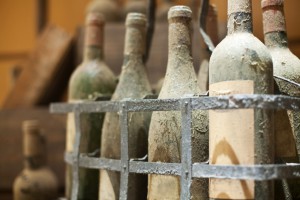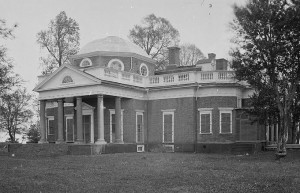
Jefferson, America’s First Wine Expert
Many people’s immediate association of Thomas Jefferson and wine is the bottle of 1787 Chateau Lafite engraved with Jefferson’s initials that sold at auction (1985) for 105,000 pound Sterling. Of course later the authenticity of the bottle(s) came into question in an extended investigation but the images of the old, dusty bottles remain.
Thomas Jefferson was America’s first wine connoisseur. Jefferson approached wine as he did virtually all subjects from architecture, science, and farming as a passion and field of constant study.
Wine appreciation and cultivation hit a fast track when Jefferson met Philip Mazzei, an Italian merchant and viticulturist. Mazzei had met Benjamin Franklin in London in 1767 and was then tempted with the idea of developing a customer base in the New World as well as the possibility of moving operations to Virginia.
In 1773 Mazzei did just that landing in Williamsburg, Virginia where within a day of his arrival he met both Thomas Jefferson and George Washington. Mazzei had come to Virginia at the urging of Thomas Adams who was seeking to develop vineyards in Augusta County.
Adams and Mazzei set out on the journey from Williamsburg to Augusta County and stopped over at Jefferson’s Monticello. In the early morning hours before much of the house had risen Jefferson took Mazzei on a tour of the lands surrounding Monticello. Jefferson showed Mazzei a nearby clearing that was for sale. Jefferson suggested that he could help negotiate the purchase of the land, as well as offering Mazzei a sizable lot of his own uncleared land to sweeten the deal.
When the two returned to Monticello the others were waiting. Adams greeted the pair proclaiming to Jefferson, “I see in your eyes that you have taken him from me. I knew you would that.”
While Mazzei expanded Jefferson’s understanding and appreciation of wine it was certainly Jefferson’s term as United States Minister to France (1785 to 1789) where he sharpened his palate. In 1787 Jefferson embarked on an epic three-month, 1,200 mile journey through France and Northern Italy. Jefferson hit many of the wine regions that are so vital today including Champagne, Burgundy, Beaujolais, Bordeaux, Languedoc, Loire, and Provence. In Italy his travels were far less extensive going no further south than Genoa.
By the time that Jefferson returned from France he had extensive knowledge of the wines of Europe and was far more experienced than any contemporary American. Many of the wines that he adored are very much in fashion today: Meursault, single vineyards in Pommard, numerous chateau in Bordeaux including Lafite and d’Yquem, Hermitage (primarily white), Spanish Sherry, sparkling Nebbiolo from Piedmont (Italy), and the Tuscan Montepulciano that he wrote, “No wine pleases me more.”

Jefferson Had a Presidential Wine Cellar
Whilst President of the United States (1801-1809) Jefferson kept an extensive cellar. In these years he spent roughly 8% of his salary on wine. He also worked within the framework of the newly-formed Republic to bring down the tariffs imposed on imported wine. Jefferson strongly believed that the health of the citizenry would be better served if wine was consumed more frequently than Port and Madeira or stronger spirits. He famously wrote that, “No nation is drunken where wine is cheap…”
Jefferson advised his Secretary of the Treasury Albert Gallatin to rework the tariffs imposed on wine bringing them more in line with other alcohol beverages. He even devised a clever chart of a new tariff scheme that was too shared with Gallatin. Jefferson argued “[T]he taste of this country [was] artificially created by our long restraint under the English government to the strong wines of Portugal and Spain.” These stronger fortified wines did travel with great ease as compared to the typical table wine that is far more delicate.
Jefferson was so enthralled by wine that in a letter to his friend James Monroe congratulating him on winning the presidency, all but six lines of this letter were devoted to wine. In this correspondence Jefferson included detailed advice on maintaining a cellar as commander in chief.
Wine and Health
While in his 30s Jefferson was advised to take wine for purposes of health. Jefferson through the years became ever convinced of wine’s medicinal properties and advised his friends and family on consuming wine for health. Later in life Jefferson in a letter that would act as an invoice for wine requested a cask of Lisbon Termo. He stated that “wine from long habit has become indispensable for my health.”
Jefferson claimed, in 1818, that “in nothing have the habits of the palate more decisive influence than in our relish of wines.”
While wine was a part of everyday life for Jefferson he was rarely (if ever) intoxicated. The Jefferson wine glass, which is on display at his Monticello home as well as the Smithsonian, is capable of holding just shy of four ounces. Today’s standard wine pour is five ounces. Jefferson limited his intake of wine to three to four glasses and most often these portions were cut with water.
Jefferson was informed in wine etiquette while in France but he never shook the English custom, of the time, of drinking wine after the meal. He served cider and sometimes ale with the meal saving the wine for after dessert.
Thomas Jefferson’s Vineyards

Jefferson Cultivated Grapes at Monticello
With the great assistance of Mazzei and his capable crew Jefferson set about to grow grapes, both vinifera (wine grapes from Europe) and local varietals. It was his desire to discover which varieties performed best in the central Virginia soils and climate and to ultimately produce America’s first great wine.
There are extensive records kept of the various plantings at Monticello and all records suggest that the experiment was at least frustrating. There was frequent replanting as varietals failed. Native grapes did thrive in selected patches but these grapes were eaten at the table. There is no credible evidence that wine was ever made at Monticello while cider, beer, and Whiskey making was an ongoing concern.
The 1807 planting of 287 rooted vines and cuttings of 24 European grape varieties was the most ambitious of seven major experiments.
The vineyards were organized into 17 narrow terraces, each reserved for specific varieties that Jefferson had received from various sources. Many of these vinifera vines had probably never been grown in the New World.
The primary cause of the failure to cultivate vinifera grapes was due to a tiny root louse known as phylloxera. This destructive pest would later devastate the vineyards of France in the mid to late 19th century. The solution was to graft the European vinifera grapes on to American varietal rootstock as the native American varieties were immune to the pest.
This fact has always caused me great angst as I can imagine Jefferson’s great joy in creating great wines from Monticello grapes with the aid of Mazzei and others. This may have been his greatest joy but it was never realized.
Jefferson’s keen dedication to growing and record-keeping lives on today. You can visit the stunning mountaintop Monticello and the extensive grounds, including the vineyards to see first-hand what nature offered him at Monticello.
